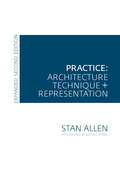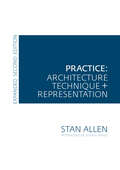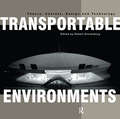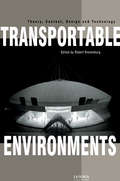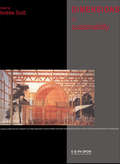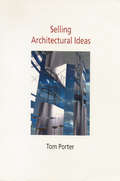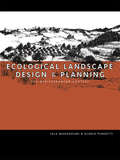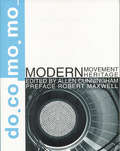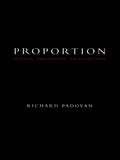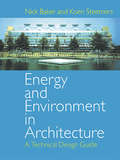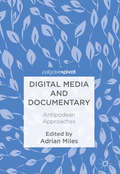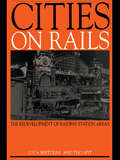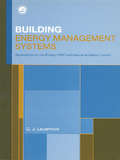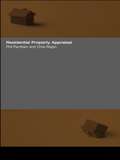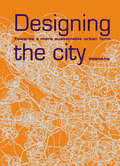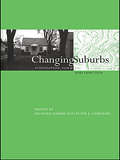- Table View
- List View
Practice: Architecture, Technique and Representation
by Stan AllenConversant in contemporary theory and architectural history, Stan Allen argues that concepts in architecture are not imported from other disciplines, but emerge through the materials and procedures of architectural practice itself. Drawing on his own experience as a working architect, he examines the ways in which the tools available to the architect affect the design and production of buildings. This second edition includes revised essays together with previously unpublished work. Allen’s seminal piece on Field Conditions is included in this reworked, revised and redesigned volume. A compelling read for student and practitioner alike.
Practice: Architecture, Technique and Representation
by Stan AllenConversant in contemporary theory and architectural history, Stan Allen argues that concepts in architecture are not imported from other disciplines, but emerge through the materials and procedures of architectural practice itself. Drawing on his own experience as a working architect, he examines the ways in which the tools available to the architect affect the design and production of buildings. This second edition includes revised essays together with previously unpublished work. Allen’s seminal piece on Field Conditions is included in this reworked, revised and redesigned volume. A compelling read for student and practitioner alike.
Transportable Environments
by Robert KronenburgTransportable Environments explores aspects of the historical and theoretical basis for portable architecture and provides an insight into the wide range of functions that it is used for today, the varied forms that it takes and the concerns and ideas for its future development. Written by a team of international commentators, this volume provides a state-of-the-art survey of this specialist area and will be of interest to a wide range of professionals across the construction and design industries.
Transportable Environments
by Robert KronenburgTransportable Environments explores aspects of the historical and theoretical basis for portable architecture and provides an insight into the wide range of functions that it is used for today, the varied forms that it takes and the concerns and ideas for its future development. Written by a team of international commentators, this volume provides a state-of-the-art survey of this specialist area and will be of interest to a wide range of professionals across the construction and design industries.
Dimensions of Sustainability
by Mit Andrew ScottThis illustrated book gives a comprehensive view of _ contemporary ideas, innovations and emerging attitudes to sustainability that emanated from the MIT symposium. 16 leading contributors with demonstrable track records in architectural practice, engineering and academia give their insights into the way we need to think about architecture in the future in order to work with the environment - instead of against it. Supported by details that relate to specific design or research projects, they clearly suggest a variety of potential directions fo follow to bring environmentalism into the mainstream of architectural discourse. The edited summary of twelve key presentations at an International Design Symposium held at MIT. This book presents an important collection of contributions from key designers with a track record in the field of environmentally conscious buildings. Their contributions respond to a need for a more holistic view on environmentalism, focusing on cultural and social levels as well as technical issues to broaden the debate on sustainable architecture. This book will appeal to a wide range of professionals in the built environment, increasingly concerned with sustainable design.
Dimensions of Sustainability
by Mit Andrew ScottThis illustrated book gives a comprehensive view of _ contemporary ideas, innovations and emerging attitudes to sustainability that emanated from the MIT symposium. 16 leading contributors with demonstrable track records in architectural practice, engineering and academia give their insights into the way we need to think about architecture in the future in order to work with the environment - instead of against it. Supported by details that relate to specific design or research projects, they clearly suggest a variety of potential directions fo follow to bring environmentalism into the mainstream of architectural discourse. The edited summary of twelve key presentations at an International Design Symposium held at MIT. This book presents an important collection of contributions from key designers with a track record in the field of environmentally conscious buildings. Their contributions respond to a need for a more holistic view on environmentalism, focusing on cultural and social levels as well as technical issues to broaden the debate on sustainable architecture. This book will appeal to a wide range of professionals in the built environment, increasingly concerned with sustainable design.
Selling Architectural Ideas
by Tom PorterAs 'visual animals' architects continue to live and work in a pictorial age in which image-making remains the central activity of environmental design. Selling Architectural Ideas explores the promotional role of architectural graphics and drawing at the point of communication, i.e. at their point of sale. By substituting the words 'communication' and 'presentation' with the word 'selling' we confront the reality of a highly competitive world in which the process of creating images for selling architectural ideas is approached as a more persuasive and, therefore, more successful design tool.
Selling Architectural Ideas
by Tom PorterAs 'visual animals' architects continue to live and work in a pictorial age in which image-making remains the central activity of environmental design. Selling Architectural Ideas explores the promotional role of architectural graphics and drawing at the point of communication, i.e. at their point of sale. By substituting the words 'communication' and 'presentation' with the word 'selling' we confront the reality of a highly competitive world in which the process of creating images for selling architectural ideas is approached as a more persuasive and, therefore, more successful design tool.
Ecological Landscape Design and Planning
by Jala Makhzoumi Gloria PungettiBased on both research and practical experience,Ecological Landscape Design and Planning offers a holistic methodological approach to landscape design and planning. It focuses on the scarcity of natural resources in the Mediterranean and the need to aim for long-term ecological stability and environmental sustainability. The principles of this approach, therefore, can be used as a theoretical foundation for holistic landscape research, creative ecological design and better sustainable practice development.
Ecological Landscape Design and Planning
by Jala Makhzoumi Gloria PungettiBased on both research and practical experience,Ecological Landscape Design and Planning offers a holistic methodological approach to landscape design and planning. It focuses on the scarcity of natural resources in the Mediterranean and the need to aim for long-term ecological stability and environmental sustainability. The principles of this approach, therefore, can be used as a theoretical foundation for holistic landscape research, creative ecological design and better sustainable practice development.
Modern Movement Heritage
by Allen CunninghamThis collection of essays serves as an introduction to modern architectural heritage and the specific problems related to the conservation of modern structures. It covers policy, planning and construction. A selection of case studies elaborates on these issues and illustrates how problems have been addressed. This volume celebrates the first 5 years of DoCoMoMo's role and influence in this important area of building conservation.
Modern Movement Heritage
by Allen CunninghamThis collection of essays serves as an introduction to modern architectural heritage and the specific problems related to the conservation of modern structures. It covers policy, planning and construction. A selection of case studies elaborates on these issues and illustrates how problems have been addressed. This volume celebrates the first 5 years of DoCoMoMo's role and influence in this important area of building conservation.
Proportion: Science, Philosophy, Architecture
by Richard PadovanThis handbook provides readers with a well-illustrated and readable comparative guide to proportion systems in architecture, setting out the mathematical principles that underlie the main systems and illustrating these with examples of their use in historical and modern buildings. The main body of the text traces the interplay of abstraction and empathy through the history of science, philosophy and architecture from the early Greeks through to the two early twentieth-century architects who made proportion the focus of their work: Le Corbusier and Van der Laan. The book ends with a reflection on the present and future role of proportion in architecture.
Proportion: Science, Philosophy, Architecture
by Richard PadovanThis handbook provides readers with a well-illustrated and readable comparative guide to proportion systems in architecture, setting out the mathematical principles that underlie the main systems and illustrating these with examples of their use in historical and modern buildings. The main body of the text traces the interplay of abstraction and empathy through the history of science, philosophy and architecture from the early Greeks through to the two early twentieth-century architects who made proportion the focus of their work: Le Corbusier and Van der Laan. The book ends with a reflection on the present and future role of proportion in architecture.
Energy and Environment in Architecture: A Technical Design Guide
by Nick Baker Koen SteemersA unique and revolutionary text which explains the principles behind the LT Method (2.1), a manual design tool developed in Cambridge by the BRE. The LT Method is a unique way of estimating the combined energy usage of lighting, heating, cooling and ventilation systems, to enable the designer to make comparisons between options at an early, strategic stage.In addition,Energy and Environment in Architecture the book deals with other environmental issues such as noise, thermal comfort and natural ventilation design. A variety of case studies provide a critique of real buildings and highlight good practice. These topics include thermal comfort, noise and natural ventilation.
Digital Media and Documentary: Antipodean Approaches
by Adrian MilesThis collection of essays by Australian based practitioner–theorists brings together new research on interactive documentary making. The chapters explore how documentary theory and practice is influenced by digitisation, mobile phones, and new internet platforms. The contributors highlight the questions raised for documentary makers and scholars as new production methods, narrative forms, and participation practices emerge. The book presents an introduction to documentary techniques shaped by new digital technologies, and will appeal to documentary scholars, students, and film-makers alike.
Digital Media and Documentary: Antipodean Approaches
by Adrian MilesThis collection of essays by Australian based practitioner–theorists brings together new research on interactive documentary making. The chapters explore how documentary theory and practice is influenced by digitisation, mobile phones, and new internet platforms. The contributors highlight the questions raised for documentary makers and scholars as new production methods, narrative forms, and participation practices emerge. The book presents an introduction to documentary techniques shaped by new digital technologies, and will appeal to documentary scholars, students, and film-makers alike.
Energy and Environment in Architecture: A Technical Design Guide
by Nick Baker Koen SteemersA unique and revolutionary text which explains the principles behind the LT Method (2.1), a manual design tool developed in Cambridge by the BRE. The LT Method is a unique way of estimating the combined energy usage of lighting, heating, cooling and ventilation systems, to enable the designer to make comparisons between options at an early, strategic stage.In addition,Energy and Environment in Architecture the book deals with other environmental issues such as noise, thermal comfort and natural ventilation design. A variety of case studies provide a critique of real buildings and highlight good practice. These topics include thermal comfort, noise and natural ventilation.
Cities on Rails: The Redevelopment of Railway Stations and their Surroundings
by Luca Bertolini Tejo SpitThe development of railway stations and their surroundings is an emerging feature in current urban projects. Based on a series of the most inspiring contemporary European examples of station redevelopment, this book will help planners and urban designers understand the specific and complex nature of station locations. Based on their extensive research, the authors, pioneers of studies in the field in the last few years, harness and expand the body of knowledge and present guiding principles and conditions for successful implementation of such planning projects.
Building Energy Management Systems: An Application to Heating, Natural Ventilation, Lighting and Occupant Satisfaction
by Geoff LevermoreEnergy management systems are used to monitor building temperature inside and outside buildings and control the boilers and coolers. Energy efficiency is a major cost issue for commerce and industry and of growing importance on university syllabuses. Fully revised and updated, this text considers new developments in the control of low energy and HVAC systems and contains two new chapters. Written for practising engineers (essential for control engineers) and energy managers in addition to being essential reading for under/postgraduate courses in building services and environmental engineering.
Building Energy Management Systems: An Application to Heating, Natural Ventilation, Lighting and Occupant Satisfaction
by Geoff LevermoreEnergy management systems are used to monitor building temperature inside and outside buildings and control the boilers and coolers. Energy efficiency is a major cost issue for commerce and industry and of growing importance on university syllabuses. Fully revised and updated, this text considers new developments in the control of low energy and HVAC systems and contains two new chapters. Written for practising engineers (essential for control engineers) and energy managers in addition to being essential reading for under/postgraduate courses in building services and environmental engineering.
Residential Property Appraisal
by Phil Parnham Chris RispinResidential Property Appraisal is a handbook not only for students studying surverying but also for surveyors and others involved in the appraisal of residential property for lending purposes. It focuses on the distinct professional competencies required by Mortgage Valuations and Home Buyers Surveys and Valuations, identifying and advising the reader on the extent and limitations of their activities. Generously illustrated, supported by real-life case studies and drawing on the latest research, professional and legal developments.
Designing the City: Towards a More Sustainable Urban Form
by Hildebrand FreyDesigning the City looks at current urban problems in cities and demonstrates how effective urban design can address social, economic and environmental issues as well as the physical planning at local level. The book is highly visual and illustrates the topic with a variety of sketches, line drawings, axonometrics and models. The author draws upon the valuable experience gained by the City of Glasgow and compares its solutions - successful and less successful - with projects in a variety of European countries.
Changing Suburbs: Foundation, Form and Function
by Richard Harris Peter LarkhamThe editors and contributors to this volume demonstrate how suburbs and the meaning of suburbanism change both with time and geographical location.Here the disciplines of history, geography and sociology, together with subdisciplines as diverse as gender studies, art history and urban morphology, are brought together to reveal the nature of suburbia from the nineteenth century to the present day.
Changing Suburbs: Foundation, Form and Function
by Richard Harris Peter LarkhamThe editors and contributors to this volume demonstrate how suburbs and the meaning of suburbanism change both with time and geographical location.Here the disciplines of history, geography and sociology, together with subdisciplines as diverse as gender studies, art history and urban morphology, are brought together to reveal the nature of suburbia from the nineteenth century to the present day.
